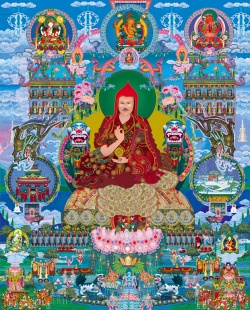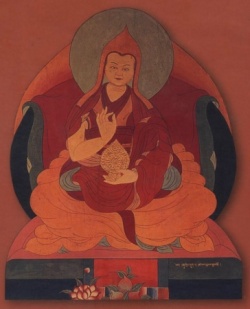Sixth Dalai Lama
TSHANGS-DBYANGS-RGYA-MTSHO
Author: FANG CHAO-YING
Tshangs-dbyangs-rgya-mtsho 策養[倉洋]嘉錯 , Feb.11, 1683-1706, the Sixth Dalai Lama and poet, was born at Mon in southern Tibet. His full name was bLo-bzang-rig-hdsins tshangs-dbyangs-rgya-mtsho (羅布藏仁青).
The year before he was born the Fifth Dalai Lama had died.
According to Tibetan law, the death of a Dalai Lama should be publicly announced, and high commissioners should then convene to select some new-born infant as the reincarnation of the deceased Lama.
This infant is then educated in the monastery, Potala, and the Panchan Lama rules at the head of a body of regents, until the child comes of age.
But this procedure was ignored in this instance as the Tipa (temporal administrator under the Dalai Lama), whose name was sDe-srid Sangsrgyas-rgya-mtsho, known in China as Sangge 桑結, did not make public the Lama’s death.
He proclaimed, instead, that the Dalai Lama, having encountered an evil omen, had retired in order to avoid its effects, and that orders normally issued by the Dalai Lama would, for the time being, be issued by himself.
In this way the Tipa usurped the full powers of the Tibetan religious ruler.
What is more, he resented the influence of the Khoshote princes and of their friend, Emperor Shêng-tsu, and looked with disfavor on the Khalkas for having their own Grand Lama.
He encouraged Galdan q. v. of the Sungars to conquer the Khalkas and to carry the war into China, should that country intervene.
In 1688 Galdan did conquer Outer Mongolia, and when Emperor Shêng-tsu declined to deliver to him the Mongols who had fled southward as refugees, he began hostilities with China (1690-97).
A representative from the Tipa, who always accompanied Galdan, acted as his army chaplain and selected the days “favorable” for combat.
Nevertheless Galdan was defeated in battle in 1690 and again in 1696; he died a year later (1697).
From certain captured Eleuths Emperor Shêng-tsu verified his suspicions (1696) that the Fifth Dalai Lama had died.
From them he learned also of the intimate relations that had existed between the Tipa and Galdan.
Consequently the Emperor demanded an explanation.
The prestige of China, after the defeat of the Eleuths, forced the Tipa to reply in a conciliatory manner and to announce that a new Dalai Lama, then fifteen sui, would occupy the throne after December 8, 1697.
It is not known when and by what method this new Dalai Lama, Tshangs-dbyangs-rgya-mtsho, was selected as the reincarnated one.
It is alleged that the infant was “recognized” as such by the Tipa who then took him from his parents.
He received his education from the Panchan Lama, bLo-bzang-ye-shes 羅桑伊喜 (b. 1663), perhaps without intimations of his future destiny; and his status was kept hidden from the public until perhaps late in 1697.
Emperor Shêng-tsu blamed the Tipa for Galdan’s misdirected military adventure and for his many defamatory statements and treacherous acts, but realistically let the matter of the new Lama drop after Tshangs-dbyangs-rgya-mtsho was proclaimed as such (the Sixth Dalai Lama according to the Tibetan calculation).
Nevertheless, the Tipa was not shorn of his power. He did not interfere when the young Dalai Lama led a life of gaiety or indulged in wine and women or in the writing of love songs.
He possibly even encouraged the young man in his excesses in order to retain for himself a free hand in state affairs.
After the fall of Galdan the influence of the Khoshotes, supported as they were by China, was again ascendant in Tibet.
In 1700 an able prince of the Khoshotes, known as Lohsan (the Latsan Khan 拉藏汗 of Chinese accounts), inherited the military authority established in Tibet by his great-grandfather, Gushi Khan.
The Tipa, perhaps annoyed by the ability of this prince, or motivated by a desire for more power and wealth, attempted twice to poison him. In both cases Latsan Khan ‘s life was saved by the quick use of antidotes.
In 1705 he revolted and killed the Tipa, and so became ruler of Tibet with the title of Chenghis Khan.
The young Dalai Lama was unmindful of these political changes and pursued his love affairs despite repeated warnings from Latsan Khan .
Their relations were thus strained to the breaking point. After obtaining the consent of Emperor Shêng-tsu, Latsan Khan sent the Dalai Lama from Lhasa, ostensibly to pay a visit to Peking, but in reality to have him murdered (1706) on the way, in Kokonor.
This accomplished, Latsan Khan denounced Tshangs-dbyangs-rgya-nttsho as dissolute and illegitimate and one who had been elevated solely on the authority of the deceitful Tipa.
He put on the throne a monk of his own choosing who ruled as Dalai Lama until the conquest of Tibet by the Eleuths in 1717.
So long as Tshangs-dbyangs-rgya-mtsho ruled in Lhasa he was doubtless regarded by many Tibetans as too erratic to be the head of the Church.
But as soon as he was deposed and executed many adherents of the faith were filled with grief, and never again doubted that he was the authentic Lama.
As the Tibetans believed that only an incarnation of the real Dalai Lama can rightfully succeed another, they refused in their hearts to recognize Latsan Khan ‘s protege.
In one of the songs, attributed to Tshangsdbyangs-rgya-mtsho, there is a line which implies that he would some day make a journey to Li-t’ang and then return.
In 1708 a child, Skal-bzan-rgya-mtsho 噶爾桑嘉木錯 (1708-1757) was born in Li-t’ang with divinely formed features, who was subsequently “found” to be the reincarnation of Tshangs-dbyangs-rgya-mtsho.
Many Mongols and some Tibetans were happy that the alleged prophecy in the song was thus fulfilled.
In 1714 the Mongols of Kokonor had the child removed to their territory and pro claimed him as the Dalai Lama.
Since Emperor Shêng-tsu did not care to be involved in the controversy, he withheld his decision; he permitted the child to reside in Sining, but saw to it that he was heavily guarded in order to prevent any ambitious Mongol prince from using him as a tool.
After Latsan Khan was killed bv the Sungars, the monk whom he had made the Dalai Lama was dethroned.
Hence from 1717 to 1720 Lhasa did not have a lawfully selected Dalai Lama.
When Tibet was recovered from the Sungars, the child in Sining was escorted to Lhasa and succeeded as the seventh Dalai Lama (in Chinese accounts the sixth because Tshangs-dbyangs-rgya-mtsho is not there recognized as a legitimate successor).
Owing perhaps to the tragic circumstances of his death, the Tibetans kept the murdered Tshangs-dbyangs-rgya-mtsho vividly in their memories; they found justification for his faults,
and perpetuated many pious legends concerning him.
His love songs became popular in Tibet, and several of them are translated by Sir Charles Bell in his book, Tibet Past and Present (1928).
In 1930 the Academia Sinica published a volume containing sixty-two of his songs transliterated into roman letters, with renderings in both Chinese and English, by Yü Tao-ch’üan 于道泉.
This work, entitled Love Songs of the Sixth Dalai Lama, Tshangs-dbyangs-rgya-mtsho, (第六代達賴喇嘛倉洋嘉錯情歌 ) contains also a portrait of the Lama.
(Love Songs of the Sixth Dalai Lama (see above); a30/la-7a; Desideri, Ippolito, An Account of Tibet (ed. by F. de Filippi, London, 1932), pp. 46-72.]

